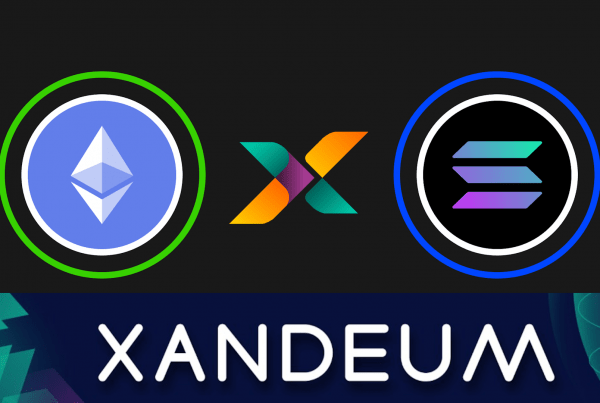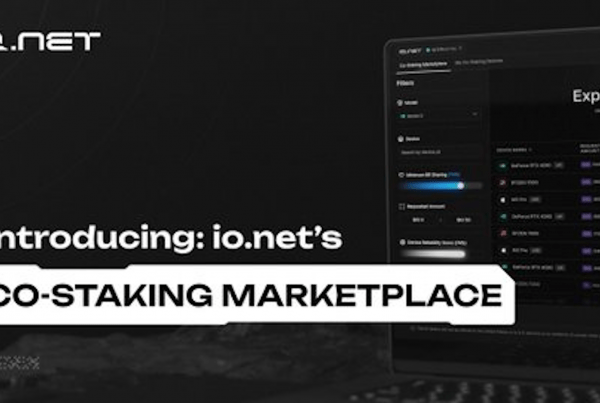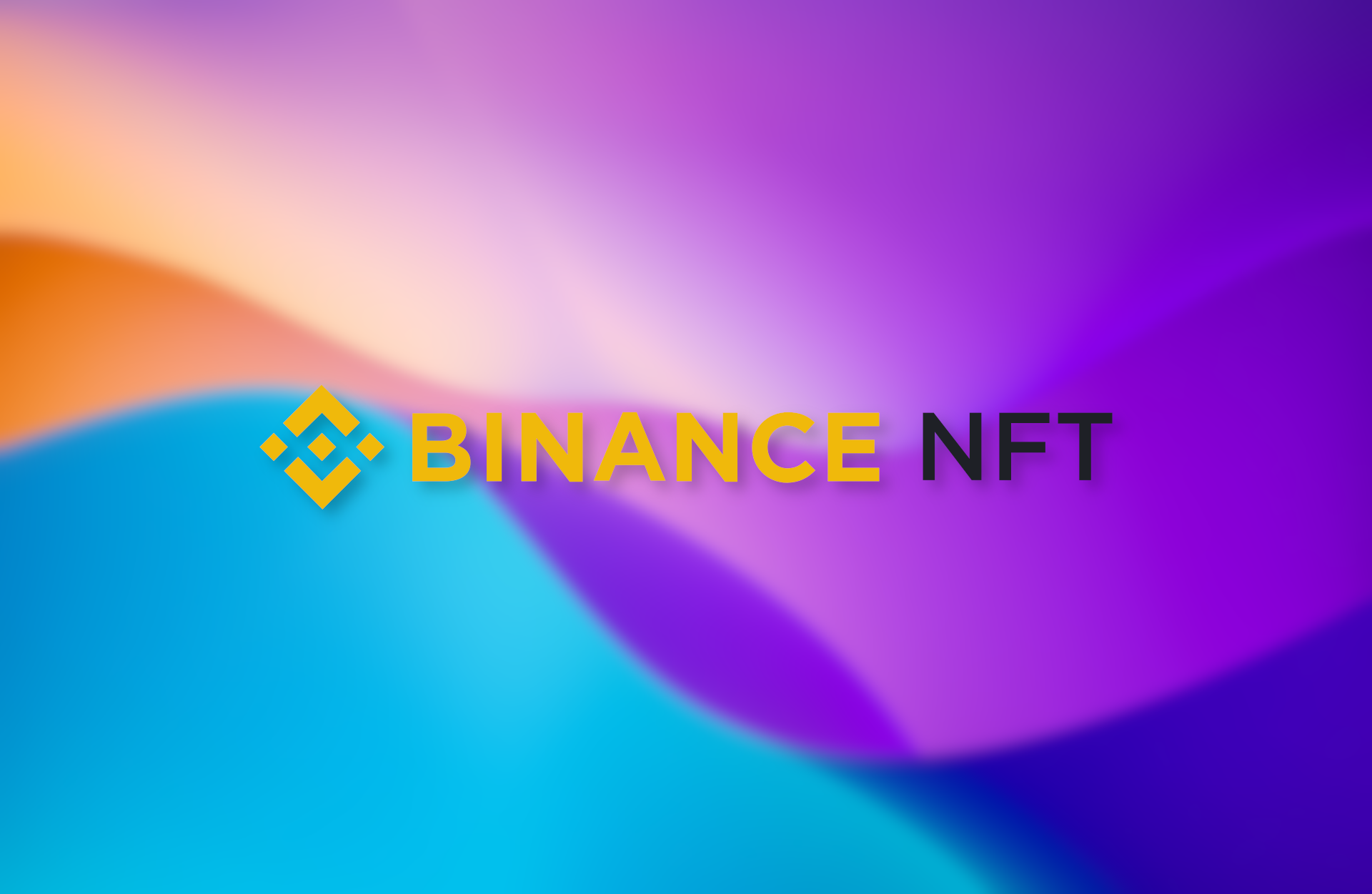
With celebrities, athletes, prominent artists, and creatives from all walks of life promoting and minting non-fungible tokens (NFTs), the technology has quickly skyrocketed from being an obscure thing talked about amongst crypto enthusiasts to being a mainstream topic of interest.
At this point, seeing an endless stream of digital collectibles reaching sky-high valuations, you’re probably wondering: “How do I go about creating my own NFT?”
Before answering this question, let’s first briefly explain what an NFT is, or better said, what can be an NFT.
What is an NFT?
In essence, NFTs are unique, non-replaceable digital assets that store ownership data on the blockchain. Sparing the technical details, NFTs are digital items that are not fungible, meaning they cannot be exchanged for something else at equivalency. Outside of the crypto realm, examples of non-fungible items include paintings, songs, diamonds, basically, everything that has unique qualities and cannot be traded at equivalency. This might sound confusing, but it becomes clearer when explaining what are fungible items, we promise.
Fungibility refers to a characteristic of items that are interchangeable with one another. Think of Bitcoin, for example – for all intents and purposes, every Bitcoin is the same as every other Bitcoin, meaning they can be exchanged with no complications, at equivalency. As the popular crypto adage goes – “1 BTC = 1 BTC”. Commodities, stocks, options, and money bills are some prominent examples of fungible items.
You can think of NFTs as an invention that serves to protect creators in an increasingly digital world, where virtually anyone can duplicate files and share them with others, with creators having little recourse to get the money they would have rightfully deserved for their work. NFTs make it possible for creators to claim ownership over their creations and earn royalties when they exchange hands.
With basic terminology out of the way, let’s examine what can be minted as an NFT.
What can be an NFT?
While it might sound like a bit of a cop-out, the imagination is virtually the only limit when it comes to answering, “What can be an NFT?” While it is easy to envision a world where insurance data, medical records, logistics documentation, notary documents, and more are stored securely on decentralized distributed ledgers, the reality is that we are not there yet. Not by a long shot.

In their current iteration, NFTs are digital assets that come mostly in the form of various forms of art, from digital illustrations to music, videos, in-game items, and alike. Most people think of abstract digital creations when thinking about NFTs, and with Beeple’s works and the Bored Ape Yacht Club reaching multi-million dollar valuations, it is easy to see why.
With so many options available, which NFT platform should I choose?
Granted, there are numerous answers to that question, with a growing number of digital asset platforms providing access to minting NFTs. However, if you value the ease of use and access to a lively marketplace of digital collectible collectors, sellers, and buyers, then Binance NFT Marketplace might just be the right choice for you.
Thanks to a recently redesigned user interface and a plethora of new features, creating an NFT collection on Binance, or minting a single NFT, is as easy as pie.
In the following sections, we’ll guide you through the process of minting your very own NFT collection.
How to mint an NFT collection on Binance
We’ve finally arrived at the meat and bones of this piece, which you are surely most interested in.
The first thing to consider when deciding to mint an NFT is to decide which blockchain should your digital creations be stored on. On Binance NFT, users can choose between two blockchain ecosystems, BNB Smart Chain and Ethereum. For the purposes of this guide, we’ll be using BSC, which is both a cheaper and faster option.
It is worth noting that you’ll need a blockchain wallet that supports BSC or the Ethereum network if you wish to move your NFTs off of Binance. Conversely, you can also choose to store your NFT on Binance NFT with no extra charge.
Decide what your NFT should be
What should your NFT collection consist of? Well, that’s entirely up to you. If you lack ideas, you could skip to a section below (“What makes an NFT successful?”) in which we talk about our subjective view of what separates successful from unsuccessful NFTs.
Create an NFT collection (step-by-step guide)
First, you’ll have to complete the identity verification and grow your Binance NFT user profile following to at least 2 followers. That shouldn’t be too hard, as you can invite your friends or family members to follow your profile or share a link to your profile on social media and increase your following that way.
If you want, you can click on the button below to follow along with our guide step-by-step.
Step 1
On the Binance NFT homepage, click Create in the upper right corner. After that, you’ll be redirected to the NFT minting page.
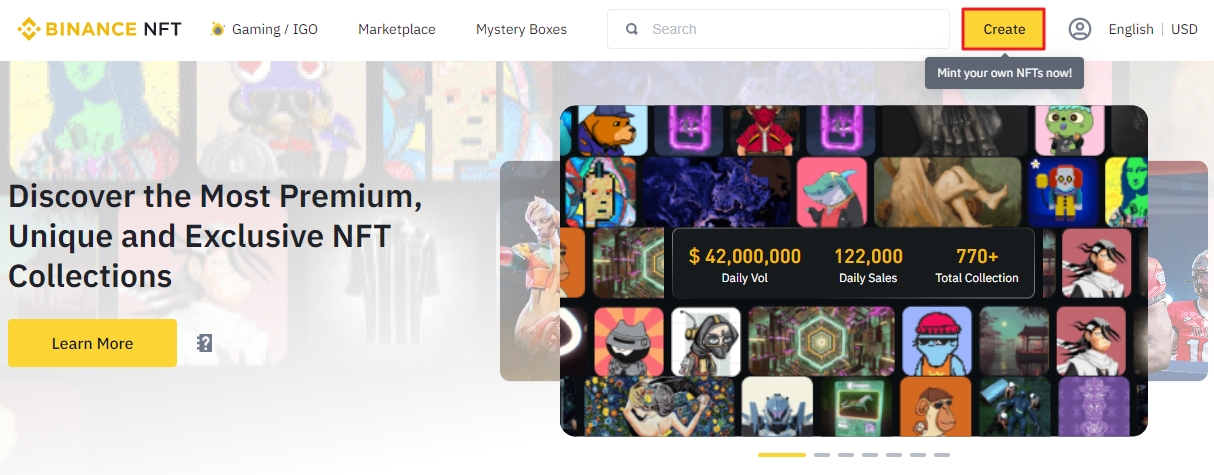
Step 2
In the pop-up that appears, click +Collection to start minting your NFT collection.
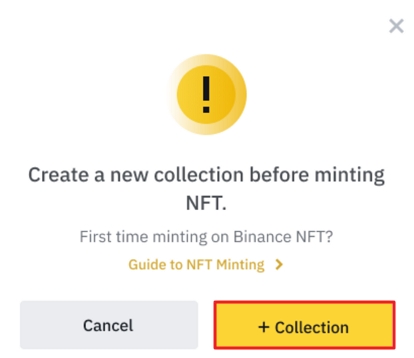
Step 3
Fill out the required details about your NFT collection. Collection name, description, royalty fee, and similar information is required to proceed. Keep in mind that changing information about your collection is not possible once confirmed. Read more about the data requirements in Binance’s NFT minting FAQ article.
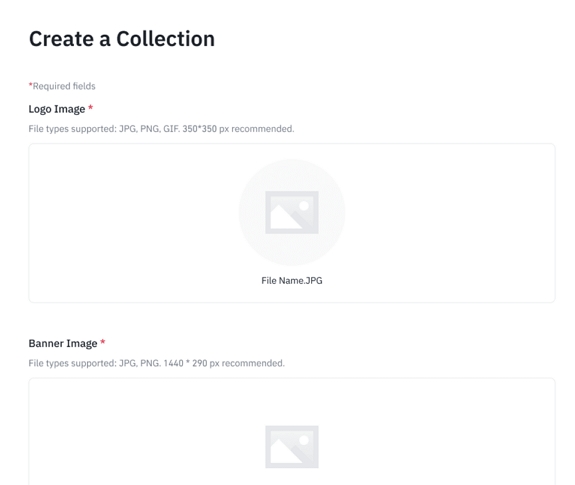
Step 4
In the pop-up, click Continue. This action will submit your collection for review. Keep in mind that creating a collection incurs a smart contract deployment fee of 0.10 ETH, or 0.03 BNB, depending on the blockchain you want to use (take a look at the “Are there any NFT-related fees I should be aware of?” section for more info). You will receive an email notifying you about the state of your application process.
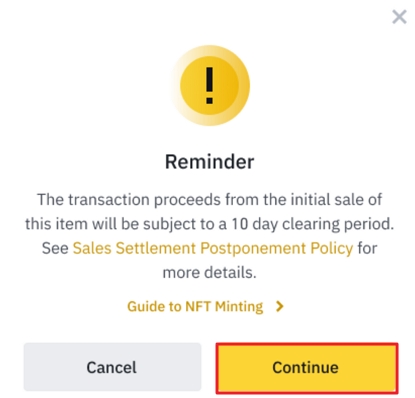
Create an NFT (step-by-step guide)
With the NFT collection that can nest your NFTs created, you can proceed by filling it with digital collectibles. Follow the steps below to mint your very own NFT.
Step 1
Navigate to the Binance NFT Marketplace homepage and click Create.
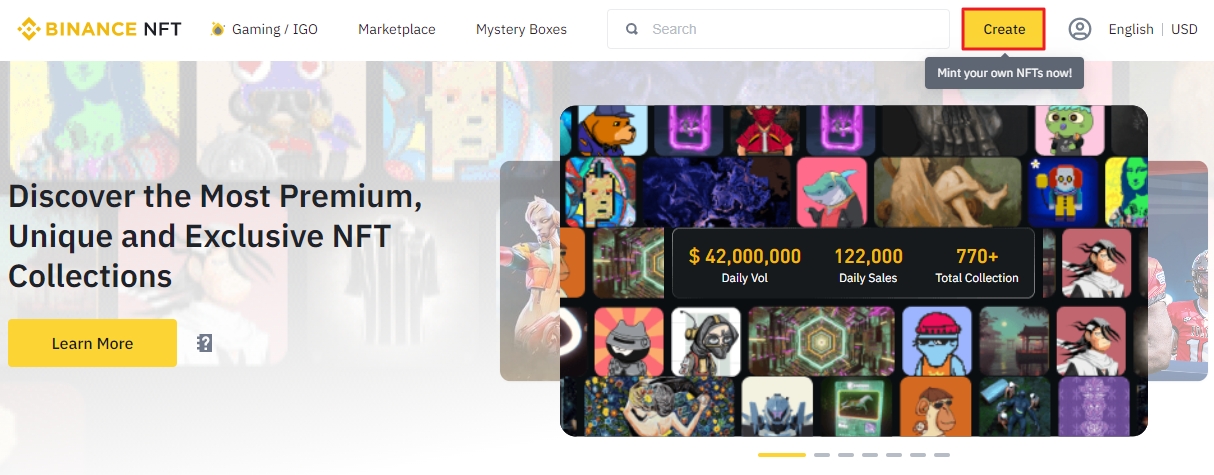
Step 2
Accept Binance NFT Marketplace Terms and Conditions.

Step 3
Proceed by supplying details about your NFT, including name, network, and collection. You will be notified about the fee you are required to pay to mint the NFT.
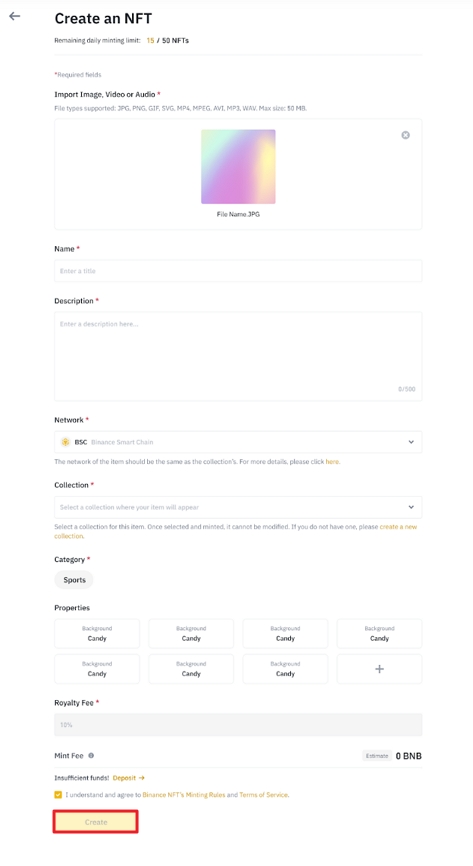
Step 4
After clicking Create to upload your file and submit it for review, the automatic verification system will do its due diligence, and notify you when the NFT is ready.
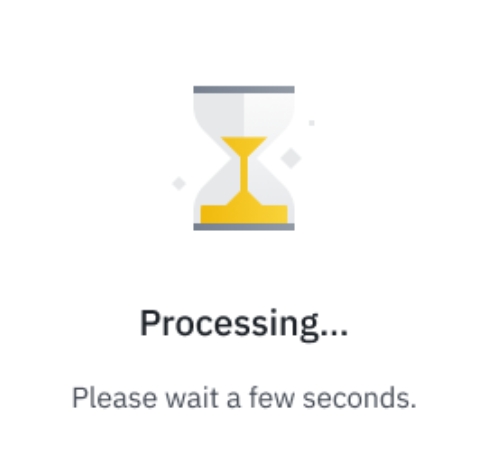
Step 5
Once the review and minting are done, you will receive the NFT contract address and Token ID.
Put your NFT on the market
After completing the steps above, you can list your NFT on the Binance NFT Marketplace by clicking on the List NFT button.
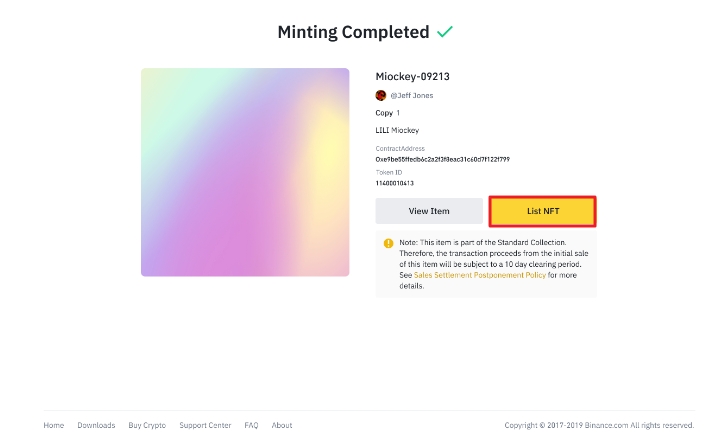
Are there any NFT-related fees I should be aware of?
Yes, when using Binance NFT Marketplace, you will need to pay fees associated with trading, minting, and withdrawing NFTs. Here’s a quick look at the different fees you will be expected to pay when using the platform:
Minting Fee
The cost of minting an NFT on Binance. Depending on the blockchain you use, you’ll be expected to pay a fixed fee of 0.005 BNB when deploying NFT on BNB Smart Chain, and 0.001 ETH when using Ethereum.
Smart Contract Deployment Fee
The smart contract deployment fee is relevant for users that wish to create an NFT collection. The cost of deploying a collection on BSC is approx. 0.03 BNB, and on Ethereum roughly 0.10 ETH.
Deposit Fee
The deposit fee is associated with putting external NFTs on Binance. The cost is subject to gas fees on the blockchain network you want to use at the time of transfer.
Platform Fee
Binance charges a flat 1% fee when a sale of an NFT occurs on its non-fungible-token platform.
Withdrawal Fee
The withdrawal fee is subject to the same external factors as the deposit fee, namely the gas fee on the blockchain network you are using. It is worth noting that the withdrawal fee is paid to network operators and not to Binance itself.
Royalty Fee
Contrary to other fees in the list, royalty fee refers to the share of proceeds creators receive when their NFT is sold. The fee is capped at 10% at the high end and 1% at the low end.
What makes an NFT successful?
We can’t outright tell you what NFT collectors will find attractive. However, looking at some of the most successful NFT collections, at least in terms of trading volume, it becomes evident that what they have in common is a combination of robust lore and/or name recognition.
That doesn’t mean that lesser-known artists or individuals with unique ideas can’t hope to create successful NFT projections, it just means that they have a harder time creating the market buzz necessary for their NFTs to reach high valuations.
Final thoughts
Binance NFT Marketplace is a great choice for users who are searching for an easy-to-use platform to make their foray into the digital collectibles space. Hopefully, this article helped clarify the crucial information regarding non-fungible tokens and successfully explained how the process of minting NFTs on Binance works.

